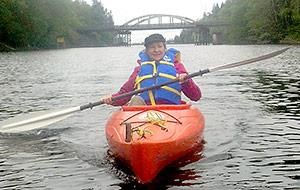by Kate Robertson I am afraid of flying, but there I was boarding a commercial plane so small that I had to duck my head to pass through the door. I was off to Powell River, the Upper Sunshine Coast’s largest city—a destination on my bucket list because I had heard great things about Desolation Sound.
Home to the largest marine park in British Columbia with 60 kilometres of shoreline and numerous small islands and coves to camp at and explore—you can understand why Desolation Sound has been referred to as a “yachters’ paradise.”
The highlight of this short weekend trip was going to be a day ocean kayaking from Lund, the closest community to the southern tip of the Sound. Just a little ditty to wet my feet before I fully immersed myself into a full week of paddling in Desolation.
Despite my nerves on takeoff, I was soon distracted by the beautiful, low altitude view as my plane skirted the coastline north from Vancouver. The Gulf Islands were clearly visible—to the east I could see the snow-capped Pacific Coast mountain range that runs all the way up to Alaska.
A warm reunion with my friend and a quick tour through the city of Powell River (enough to make me want to see more), and we were on our way to Lund to scope out kayak rentals and see where we could start our paddle the next day. Lund is a tiny village that swells with tourists in the summer season—people accessing the Sound or the ferry going over to Savary Island, buying seafood from the local fishermen, or just hanging out and visiting the unique cafés and shops.
Prayers to the weather gods that the steadily deteriorating forecasts were wrong didn’t help. I awoke on Sunday morning to the sound of rain pattering on the roof and when I looked out the window, I could see trees leaning in one direction from more than a gentle breeze. Ocean kayaking can be challenging enough in dealing with the tides and currents, without paddling in high waves and wind. Add to that possible fog and low clouds limiting visibility. I was not keen on a test of my deep water re-entry manoeuvres on a chilly day.
Ocean trip abandoned, on to Plan B, a paddle of the more-protected Powell Lake, located adjacent to the city of Powell River and which empties into the Strait of Georgia through Powell River (the second shortest river in the world at just 500 metres long). When we put in at Mowat Bay beach, it had stopped raining and despite a steady wind and some choppy water it seemed manageable to paddle, so we headed up-lake hugging the eastern shoreline and aiming for an ultimate destination of Henderson Bay to see the float cabin, or so we thought.
Not long into the trip we realized we were getting nowhere fast. Indeed, the waves were not only getting bigger and coming faster, but were starting to come from different directions, like the agitator in a washing machine switching up from the delicate cycle to heavy duty. Just as I got angled in one direction to meet a wave, the next wave was bearing down from a different direction. We were drifting closer to the centre of the lake than the shoreline. Plan C: turn back to shore.
By the time we neared shore the wind had significantly died down. Finally, we were able to rest and paddle leisurely and enjoy the quiet and the views. I could now appreciate the dark bottomless-looking water (one of the deepest lakes in British Columbia), joggers on the trail that borders the lake, the marina and restaurant across the river, the glimpse of Georgia Strait under the bridge and the exotic-looking (or at least to a native Albertan) arbutus trees sprinkled among the evergreen forest. To top it all off ma and pa Canada Geese were giving their three babies swimming lessons.
As we paddled back toward our home beach, I felt exhilarated. It may not have been the ocean adventure that I was hoping for, but it was definitely an adventure. I have since read that lake waves can be steeper and more likely to break than those on the sea. Great experience before my expedition up Desolation Sound, don’t you think?



